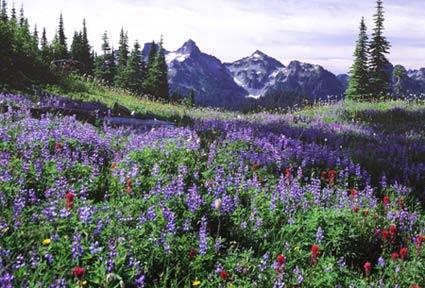“Does any skeptic suppose that a true mountaineer regrets any heroic mountain exploit because of some mishap…does he suppose that any of the many zealous navigators who sailed in that vain quest, the discovery of the mild open sea about the North Pole, bewailed the suffering he endured or the brave efforts he made? Does he imagine that man will ever cease his attempts…to reach the summit of unconquered peaks, simply because of possible mishaps and sufferings attendant thereon?”
Philemon B. Van Trump, a pioneering mountain climber from Washington state, wrote these words in 1894, just after he became the first white man to reach the summit of Mt. Rainier. It is largely thanks to his and other local adventurers’ efforts that Mount Rainier is preserved.
Congress established Mount Rainier National Park on this date in 1899, making it the first park to be established after the creation of the National Forest System. This is crucial, as it represents one of the first steps towards making sure that parks would be preserved instead of managed for resource extraction, as the forests are.
Moreover, much of the new park’s lands were carved from preexisting forest reserves and local railroad company lands. This idea of taking land considered at-risk to make a park first took hold at Mount Rainier, and today is a hallmark of national parks.
Unlike many parks however, the movement to conserve Mount Rainier first gathered steam in Washington state, not across the nation, and the effort to protect it was primarily a local one. Scientists from the area, as well as local mountain enthusiasts and even the Northern Pacific Railroad, all had a hand in the creation of the park.
The railroad realized that it could make a veritable mint off new parks, so in 1883, it brought dignitaries from around the world to Mount Rainier, including Senator George F. Edmunds of Vermont.
“I would be willing to go 500 miles again to see that scene,” the senator wrote in the Portland Oregonian. “This continent is yet in ignorance of the existence of what will be one of the grandest show places…I can not help saying that I am thoroughly convinced that no resort in the United States will be so much sought after as this when once people come to know that what men cross the Atlantic to see can be seen in equal splendor, if not surpassed, at home. I have been through the Swiss mountains, and I am compelled to own that incredible as the assertion may appear, there is absolutely no comparison between the finest effects that are exhibited there and what is seen in approaching this grand isolated mountain.”
As the park movement gathered steam throughout the late 19th Century, Washington state's senators and congressmen introduced legislation in six consecutive sessions of Congress looking to establish a "Washington National Park." While there wasn’t much in the way of organized opposition, Congress didn’t feel that it was the federal government’s job to create a whole slew of parks across the nation.
In essence, most in the government felt that Yellowstone would be an isolated event. But finally, in 1899, President McKinley signed legislation creating Mount Rainier National Park. Much of the law creating the park was taken verbatim from Yellowstone’s founding legislation, and Mount Rainier can take pride in that it was the first park that was unambiguously modeled after Yellowstone.
Visit Mount Rainer today and you'll be able to experience a wide array of settings, from temperate rainforest in the northwestern corner via the Carbon River Entrance to glacial conditions that lure mountaineers from around the world. Meadows at Paradise explain how the area got its name when they bloom come springtime, and the Wonderland Trail that rings the mountain much like a 93-mile-long necklace offers travelers a multi-day wilderness sojourn.
A Mount Rainier visit also would display Mother Nature's power, as the park endured much damage from a potent storm that raged through the Northwest in November 2006. Folks who make it to the park this year will be among the first see the newly restored Paradise Inn, which is scheduled to open in May after two years of rehabilitation.
While the primary adventure is exploring the mountain on foot via the park’s excellent trail system, visitors can also go bicycling, boating/fishing, or simply relax at one of the park’s nine developed areas and campgrounds.




Comments
Snowbird06
Chance, your story inspires me to conquer Mt. Rainier this summer. Good job and keep writing for: "the pen is mightier then the sword".